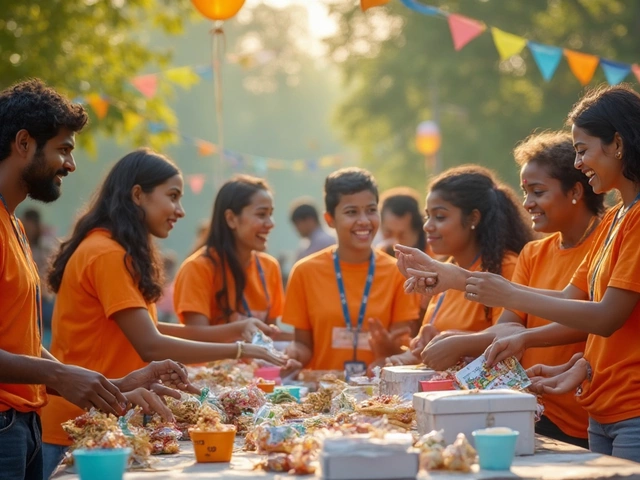Think charities are just about passing a basket for donations? Not even close. These organizations run on real action—planning, hustling, and pulling people together for a shared cause. Sure, money matters, but it's the events, teamwork, and hands-on projects that really drive things forward.
No two charities run things exactly the same. One might focus on a fun run or a bake sale, another on serious community cleanup or training workshops. The secret? Matching activities to the crowd they're trying to reach and the goals they're chasing. Not every event has to be fancy—some of the most successful ones are simple, like a neighborhood clothing swap or a schoolyard read-a-thon.
And here's a wild fact: according to a 2024 survey by Charity Navigator, over 60% of donors say they're more likely to give again if they see fresh, creative events instead of the same old dinner galas. People want to feel the buzz, not just pull out their wallets. So, as you look to get involved or set something up, knowing what types of activities work—and which ones really fire up a community—can make all the difference.
- Classic Charity Events That Work
- Creative Fundraising Ideas
- Volunteering in Action
- Measuring Impact and What Comes Next
Classic Charity Events That Work
When people think of charity, the first thing that usually pops into mind is a big event—something that gets folks excited and brings them together for a cause. The classics are classics for a reason: they work. Let's walk through some of the tried-and-true events that keep charities running and communities involved.
First up, charity events like fundraising dinners and galas. According to the Nonprofit Times, dinner galas in 2023 raised an average of $80,000 per event for midsized organizations in the U.S. But here's the thing—not every organization has to start with a five-star meal. Spaghetti suppers held at local churches and pancake breakfasts at community centers pull in support, too, sometimes with even more charm than the fancy sit-downs.
Another fan favorite is the community fun run or walkathon. In 2022, Susan G. Komen's "Race for the Cure" events raised more than $35 million across the country. These events are awesome for getting lots of people moving and involved, especially families. They're also pretty low-stress in terms of planning—find a safe route, get some volunteers, and you're off.
Then there are charity auctions and raffles. Live auctions—think school gym full of parents and neighbors waving paddles—can rake in serious dollars, especially if you get local businesses to donate items or experiences. Even a simple online silent auction can gather bidders from all over. Raffles are easy to put together and work great at any gathering. Just be sure to check local rules; some places have specific laws about games of chance.
- Fundraising dinners or pancake breakfasts: Brings in community spirit and donations.
- Fun runs, walkathons, and bike rides: Great for raising money and awareness with broad participation.
- Auctions and raffles: Flexible and engaging for both small crowds and big communities.
- Book sales, bake sales, and yard sales: Old-school but reliable, perfect for smaller groups or schools.
Want to know why these work? Giving USA’s 2024 report puts it simply: “Events that create a sense of belonging and fun generate more donations and long-term commitment.” Or as fundraising coach Lori Jacobwith puts it:
“People don’t just show up because of the cause—they come because it feels good, they want to connect, and they love a reason to celebrate.”
So the next time you're looking to raise money or awareness, start with the classics. There’s a reason everyone still uses them—they bring people together, and that’s what makes the difference.
Creative Fundraising Ideas
People get tired of the same old bake sales and charity auctions. Luckily, there are tons of new ways to keep people interested—and actually raise more money along the way. The trick is picking ideas that match your team’s style and the mood of your community. And if you can make them fun, you’ll pull in even more people.
Let’s talk numbers for a sec. According to the Nonprofit Research Collaborative’s 2024 report, events with a fresh spin—like game nights, trivia tournaments, or challenge-based fundraisers—pulled in 32% more donations than classic sit-down dinners.
- Charity activities like guided walking tours or “experience auctions” are blowing up. When people bid on an experience, like having coffee with a local sports legend or a behind-the-scenes tour of a cool business, donations go way up because the prize feels personal.
- Peer-to-peer campaigns take the fundraiser right to people’s phones. Anyone can start their own mini-drive for your cause using personal stories. This is how the Ice Bucket Challenge went viral—regular folks felt like they were a big part of something huge.
- Fitness challenges stay popular—walk-a-thons, dance-offs, or ‘steps-per-day’ contests. They’re super shareable online, and people feel good getting active for a reason. One major children’s charity in the UK raised over $9 million in 2024 just from sponsored fitness events alone.
- “Pay-what-you-want” drives can surprise you. Local coffee shops and restaurants let people choose how much to pay for a dish or drink, and all the profits go to charity. Sometimes, total donations end up higher than even ticketed events.
If you’re planning an event, think about partnerships, too. Local businesses love teaming up for good PR and often throw in matching donations or donate a cut of their sales on event day.
| Idea Type | Avg. Funds Raised (USD) | Best For |
|---|---|---|
| Experience Auctions | $8,500 | Community-driven events |
| Online Peer Campaigns | $3,200 | Wider audiences, digital push |
| Fitness Challenges | $6,000 | Schools, sports clubs |
| Restaurant Giveback Nights | $2,700 | Food lovers, local businesses |
Switching things up and trying new ideas doesn’t just keep people interested—it can also boost your bottom line. Stay open-minded, get folks talking, and see what combinations fire up your crowd the most.

Volunteering in Action
Rolling up your sleeves is where charity work gets real. Volunteers make things happen, whether they're sorting food at the pantry, helping build a playground, or just showing up with muscle and good energy. Sometimes it’s just a few hours at a local event. Other times, it’s a regular gig every month.
If you think volunteering’s just about stuffing envelopes or washing dishes, think again. These days, charities need folks who can rock social media, snap good photos, or even code. There are virtual opportunities, too—like tutoring online, running remote fundraisers, or making phone calls. You don’t have to be a pro, either. On-the-job learning is pretty common, and almost every charity will find a use for whatever skills you have.
Here are a few classic ways volunteers jump in:
- Serving meals at a homeless shelter or community kitchen
- Mentoring youth in after-school programs
- Cleaning up parks, rivers, or beaches as part of a group effort
- Helping out at charity thrift shops or donation centers
- Coordinating logistics at major charity events, like fun runs or food drives
- Offering tech support or administrative help for charity office teams
If you want the big picture, check this out: According to the 2024 Volunteering in America report, nearly 23% of adults gave their time to charities last year. That's millions of people chipping in for something bigger than themselves—and it adds up fast.
| Type of Volunteering | Typical Time Commitment | Most Needed Skills |
|---|---|---|
| Event Support | 1-2 days per event | People skills, organization |
| Tutoring/Mentoring | 1-4 hours/week | Patience, subject knowledge |
| Food Distribution | 2-6 hours/month | Reliability, teamwork |
| Remote Tasks | Flexible | Communication, digital skills |
One tip: When you sign up, ask for clear job details and a quick intro or training session. You'll feel more confident and help things run smoother. Always remember, every volunteer—no matter their role—plays a part in powering charity activities and making those big goals possible.
Measuring Impact and What Comes Next
Ever wonder if all that work—from planning to cleanup—actually moves the needle? Measuring how well your charity activities work is huge, not just for bragging rights, but to show donors and volunteers where their time and money go. Most charities track a mix of numbers and stories: how many people turned up, funds raised, meals served, or even new volunteers gained.
Here’s a quick look at some numbers that matter:
| What to Measure | Why It Matters | Common Tools |
|---|---|---|
| Funds Raised | Shows financial results | Event reports, donation software |
| Volunteers Engaged | Builds support network | Sign-in sheets, apps |
| People Helped | Shows real-life impact | Surveys, registration forms |
| Social Reach | Spreads the word | Social media analytics |
The Red Cross, for example, reports that in 2023, every dollar spent brought $4 worth of assistance, simply by tracking how resources turn into direct help. That’s a benchmark worth chasing.
Once you’ve counted heads and tallied dollars, what’s next? Take what you’ve learned and use it to level up. Maybe last year’s trivia night brought in a crowd, but a lot of young folks left early. Why? A simple online survey can give you answers—maybe the snacks stank, or the vibe was off.
- Check your stats after every event.
- Talk to your volunteers and guests. Honest feedback is pure gold.
- Experiment with something new each year. If it flops, switch it up.
If you’re not sure where to start, plenty of free online tools, like Google Forms and SurveyMonkey, make it easy to grab honest feedback. Once you get the hang of it, measuring and improving becomes second nature. That’s how small charity events grow into something much bigger down the line.







